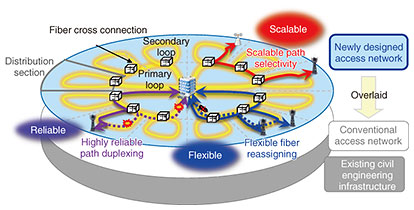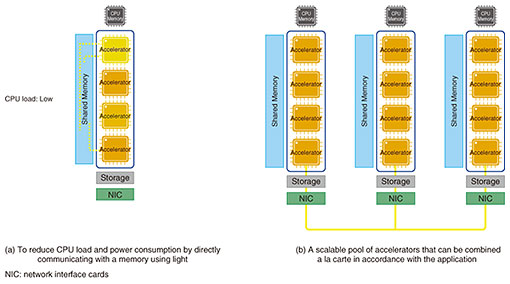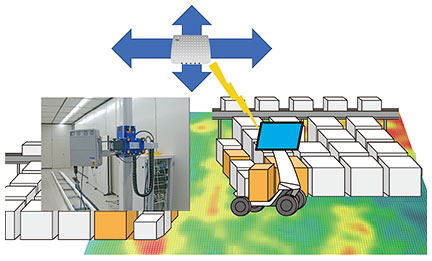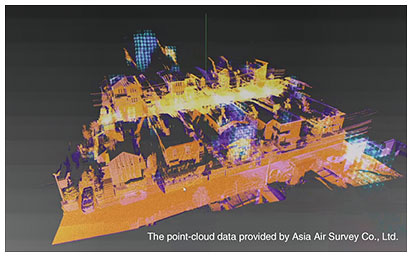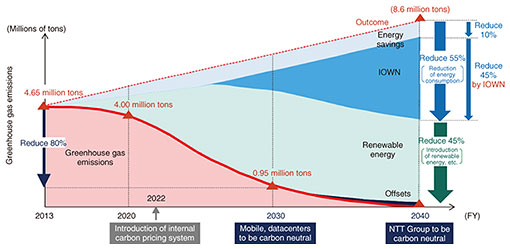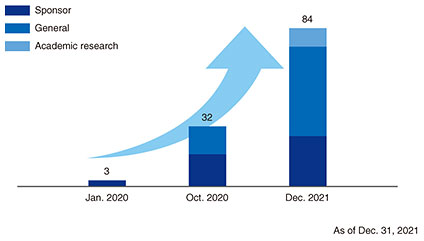 |
|||||||||||||||||||||||||
|
|
|||||||||||||||||||||||||
|
Feature Articles: Keynote Speeches at NTT R&D Forum—Road to IOWN 2021 Vol. 20, No. 2, pp. 19–31, Feb. 2022. https://doi.org/10.53829/ntr202202fa2  Road to IOWN 2021AbstractThis article presents a lecture given by Dr. Katsuhiko Kawazoe, NTT Executive Vice President, Head of Research and Development Planning Department, at NTT R&D Forum 2021—Road to IOWN 2021 held from November 16th to 19th, 2021. Keywords: IOWN, connection of Umwelten, concatenated loop topology, photonic disaggregated computing, Cradio®, 4D digital platform™, infinite clustering, NTT Green Innovation toward 2040 1. IntroductionWe announced the concept of the Innovative Optical and Wireless Network (IOWN) in May 2019. At NTT R&D Forum in 2019 and 2020, I spoke about its goals, objectives, and base technologies. This is the third year of the IOWN initiative, so I would like to focus on its progress and expansion. Since some of you may be hearing about IOWN for the first time, let me start with the concept. 2. Negative aspects of human developmentThe concept of IOWN stems from the current situation of humanity and technology. Humanity has made various technological innovations that have brought about a more affluent world. However, the novel coronavirus (COVID-19) has made all of us realize that we are now faced with unprecedented challenges and that our current technology is not sufficient to solve them. We need to improve our approach to innovation drastically. However, the current approach to technological innovation has had serious negative effects, i.e., the depletion of resources, biodiversity loss, environmental destruction, and global warming (Fig. 1). I feel that if this trend continues, the Earth and all living beings on it will be overburdened, and both humanity and all other living beings may perish. It is believed that the environmental destruction of Easter Island, famous for its Moai statues, was caused by deforestation stemming from a population explosion. This caused the soil to drain into the sea, depleting resources and causing conflicts over resources. Our current technological infrastructure is surrounded by these contradictions and paraconsistencies; economic development and environmental protection, industrial production and resource conservation, and information and communication technology (ICT) development and power consumption.
3. What kind of innovation do we need?What kind of innovation do we need to create a sustainable society? The answer is innovation that achieves a significant performance improvement of the technological infrastructure without placing a burden on the Earth. Our conclusion is that we should not focus only on humans, but also recognize and implement innovations for all living beings and the entire Earth as a whole system. We should do our best to widely adopt the technologies that will have the least impact on Earth. 4. How to do it?What we have been proposing as an effective strategy for recognizing and using the total system is the “connection of Umwelten” (Fig. 2). The world as we humans perceive it is not all there is. Various Umwelten exist around us, for example, the Umwelten of insects, reptiles, and fish. Perhaps even non-living things, such as viruses, have their own Umwelten. To understand the world made up of various Umwelten, we need to use the wisdom and value of each of them. This is the “connection of Umwelten.” To do this, we need to overcome two barriers.
5. BarriersThe first barrier is the understanding all Umwelten. In the past, humankind has learned from nature to enhance wisdom and promote innovation. However, this is very limited. There are still many Umwelten that have yet to be approached. Bioengineering and biotechnology are truly academic disciplines that discover the characteristics of various living beings and apply them to our society. It will be necessary to learn not only from the Umwelten of living beings but also from those of non-living things such as viruses. As you all know, viruses are not living organisms, but they have a great impact on humanity. If we can understand the mutation process of viruses, we can bring a ray of hope to many people. The second barrier is the technological infrastructure for connecting Umwelten. We need to go beyond humanity’s Umwelt and choose those that are useful for improving well-being and create a connection that does not place a burden on the Earth. This requires information processing more complex and extensive than ever before. We believe that the expansion of optical technology can help solve this problem. Optical technology has been mainly applied to the transmission of information via optical fiber. This has created a significant increase in transmission speed and capacity. Compared with electricity, light has great potential in terms of energy consumption (Fig. 3). Therefore, we need to overcome technology barriers and extend optical technology from transmission to information processing.
6. Concept of IOWNNTT has been conducting extensive research and development of optical technology since the 1960s. This is extending from information transmission to information processing. In information transmission, optical technology has progressed mainly through the evolution of optical fibers and technological innovations in transmission processing technology, such as digital signal processors. In information processing, we have been unable to create a breakthrough technology that surpasses electronics technology. In April 2019, however, NTT succeeded in inventing the world’s first optical transistor [1]. This is the origin of the concept of IOWN (Fig. 4). Since then, we have succeeded in inventing a variety of optical devices and found a means of extending optical technology to information processing.
In artificial intelligence (AI), for example, research and development is currently underway worldwide to improve its capabilities. We believe that we can make progress with a completely different approach. Current AI research is believed to be a technology to achieve the goals set by humanity. However, as I mentioned, we need to find yet unknown Umwelten and understand them. The increase or decrease in the number of people infected with COVID-19 may be one such subject. A future AI needs to know the unknown. As I have said repeatedly, this AI must not burden planet Earth but should instead lead to the well-being of the whole planet. To create such a world, the NTT Group is focused on the concept of “Self as We.” Self as We refers to the concept of “I” as “we.” It is the idea that my existence is supported by connections with all types of entities, including people, things, and technologies. Therefore, we need to maximize the well-being of “us” through altruistic coexistence. Since nature is altruistic and we are a part of it, we need to live in harmony with nature. Through the concept of IOWN, we will promote initiatives to achieve a sustainable society by simultaneously achieving growth and solving social issues. 7. Latest progress in the IOWN initiativeI will now discuss the latest progress in the IOWN initiative. This started with the invention of the optical transistor by one of NTT’s research laboratories and has now spread to the entire NTT Group and beyond—to a global level. I will explain the progress in the technologies that have already been announced, as well as 15 new technologies that will be announced for the first time (Fig. 5).
7.1 All-Photonics Network (optical access network design based on concatenated loop topology)The first technology is our new access network, the optical access network design based on concatenated loop topology, which is a component of the All-Photonics Network (APN) introduced in 2021 [2]. To create a smart society in areas such as telemedicine and automated driving, the APN will provide a reliable and flexible infrastructure-of-infrastructure. The new IOWN optical access network will evolve significantly in three areas, i.e., reliability, tolerance for fluctuation of service demand (flexibility), and optical-path selectivity (scalability). To achieve these goals, we established the optical access network design based on concatenated loop topology (Fig. 6). Circular optical fiber primary loops spread from the NTT building (central office), and secondary loops are connected to them via fiber cross connections. Mobile base stations are connected to secondary loops. This configuration improves reliability because there are multiple routes between the NTT building and mobile base station. The number of core lines can also be flexibly allocated according to demand, and unexpected increases in demand can be quickly accommodated. Neighboring mobile base stations can also be connected to each other without having to go through the NTT building.
We also clarified the appropriate value of design indicators for this new network through theoretical calculations based on reliability engineering and probability theory. We developed a remote optical-path-switching node that does not require commercial power supply and confirmed the principle of the variable optical branching ratio. We will continue to promote research and development of this technology for practical use. 7.2 Distance ZeroThe second technology is Distance Zero, a technology to overcome the physical distance brought about by the APN. We succeeded in reducing network-latency fluctuation to the microsecond level, which is close to the physical limit between locations, for communication of more than 100 Gbit/s per wavelength [3]. By installing an IOWN adapter at the user’s location, we can provide a 100-Gbit/s communication path to a user’s device with no latency fluctuation. IOWN adapters enable overheadless 1000-km long-distance transmission by transporting uncompressed or slightly-compressed HDMI (high-definition multimedia interface)/DisplayPort and USB (universal serial bus) signals through over-100-Gbit/s optical paths of the APN. Even with the APN, which can provide overwhelmingly low latency compared with conventional Internet Protocol (IP) networks, there are physical limitations such as the speed of light and occurrence of network latency depending on the communication distance. We developed a technology that enables the APN to automatically compensate for the delay difference. Distance Zero will enable e-sports events to be held in various cities under fair conditions, i.e., the same delay difference among various cities. We will continue to improve this technology by taking advantage of the APN’s high-capacity, low-latency, and zero-fluctuation performance. Our aim is to create a future where users can easily participate in e-sports without a game console. 7.3 Bidirectional wireless transmission using a Van Atta array in Beyond 5GI’ll now talk about new innovations in IOWN’s W, i.e., wireless, which is connected to the APN. Many of the technologies related to IOWN are based on simple principles. The wireless technology I am about to talk about is also simple but greatly effective. There is no need for complex processing. We focused on the principle of the Van Atta array antenna, which is based on retroreflection, a method of engineering radio waves so that they are reflected directly back to the source no matter from what direction they hit. By adopting the Van Atta array, it is possible to construct antennas with retroreflective properties in the most compact and simple way possible. For drastic performance improvement of wireless systems, we, with the Tokyo Institute of Technology, successfully demonstrated the world’s first bidirectional wireless transmission using a Van Atta array [4]. In wireless communication using high-frequency bands, such as millimeter or terahertz waves, which will be used in beyond fifth-generation mobile communication systems (Beyond 5G), it is necessary to form a sharp directivity by controlling the phase of each element of the arrayed multi-element antennas and always direct the antenna towards the communication partner because the propagation loss of the signal is large. This requires complex signal processing and directivity control mechanisms to track the moving communication partner. The Van Atta reflector array antenna we demonstrated can be applied to telecommunication, reflect radio waves in the direction of incidence without complicated signal processing and control, and further reduce power consumption by eliminating the complicated functions of beam selection and antenna directivity control that conventional wireless base stations and terminals have. We will promote the practical application of this technology in a wide range of wireless systems. 7.4 Wired-and-Wireless Convergence Network technologyIn preparation for Beyond 5G, the NTT Group has begun considering the Wired-and-Wireless Convergence Network. In the next generation after 5G, features of mobile and fixed networks are expected to be merged to create unprecedented services, and you will not notice the difference. The Wired-and-Wireless Convergence Network consists of function dedicated networks (FDNs) for each virtual endpoint function. By placing virtual endpoints as communication endpoints on the computing infrastructure, and connecting them with an FDN for each function, seamless communication can be provided at the end of the network without users noticing the access or terminal. With this network-fusion technology, the fusion of cyberspace and real space, as well as computers and networks, will be further developed. Not only humans, but also a wide variety of objects will be able to communicate without being restricted by communication environment, location, or terminal type, enabling the creation of a new generation of services that require high stability and reliability. 7.5 Disaggregated computing: memory-centric architectureI will now talk about the progress in disaggregated computing in which distributed computing devices are connected by light. The computational efficiency of accelerators, such as graphics processing units (GPUs) and field-programmable gate arrays (FPGAs), has dramatically improved compared with that of central processing units (CPUs), which are general-purpose processors. However, when sharing and passing data between accelerators, the CPU is involved, which reduces efficiency in terms of processing speed and power consumption. To solve this problem, NTT has devised a computer architecture in which the accelerators are equipped with optical communication functions, allowing them to communicate directly with the memory using light (Fig. 7(a)). This dramatically improves the processing performance of the computer and reduces the CPU load and power consumption. The architecture consists of a scalable pool of accelerators that can be combined a la carte in accordance with the application, enabling a highly scalable and efficient computing infrastructure (Fig. 7(b)). We call this new computing architecture the memory-centric architecture.
We developed a prototype of the memory-centric architecture using a conventional device and verified its effectiveness using video-based AI inference as a test case. We confirmed that it reduces power consumption by about half compared with the conventional architecture. We estimate that power consumption will eventually be reduced to about 1/20 that of the conventional architecture through the evolution of photonics-electronics convergence technology and further development of this architecture using this technology. 7.6 Security-transparency-assurance technologyThe next technology I will discuss is the security-transparency-assurance technology, which uses IOWN’s photonics-electronics convergence technology to solve the security problems of decentralized computer devices. Decentralization increases the risk of malicious software and hardware. Therefore, visibility and inspection of the hardware and software is necessary to improve security transparency. NTT is developing this technology in collaboration with NEC Corporation [5]. I will now introduce the elemental technologies of the security-transparency-assurance technology, i.e., a technology for analyzing the software configuration of telecommunication equipment and a backdoor inspection technology for detecting illegal functions in software. To externally inspect communication equipment, we match device-specification data with device-operation data to detect out-of-specification behavior. We achieved the detection of out-of-specification code that does not normally run by directly analyzing the binary code inside a device. This technology will allow for versatile, high-performance and secure white boxes consisting of software and hardware devices supplied by multiple vendors to become the next generation of communication devices. NTT calls such super high-performance general-purpose devices super white boxes, which will be applied to various IOWN communication-infrastructure devices. 7.7 Post-quantum cryptographyI’ll talk about cryptography for the IOWN era, the era of quantum computers. Quantum computers are expected to be applied to various fields, but if they are put to practical use, there is a possibility that existing cryptography, which ensures a secure communication infrastructure, will be broken. Research on the next generation cryptography post-quantum cryptography (PQC), which cannot be broken even by quantum computers, is being conducted worldwide. The NTRU (Nth Degree Truncated Polynomial Ring Unit) cryptography developed by NTT includes security-enhancement technology that can be applied to PQC. It is one of the last remaining candidates in the PQC standardization activity at the U.S. National Institute of Standards and Technology and is highly evaluated by cryptographers around the world [6]. We would like to combine this cryptography to construct a robust communication system. 7.8 Cradio® multi-radio proactive control technologiesI will now talk about the progress in the Cognitive Foundation® that enables rapid deployment and configuration optimization of ICT resources. Beyond 5G requires extreme coverage that can connect and stay connected across land, air, underwater, space, indoors, as well as outdoors. A promising method for achieving extreme coverage is the moving base station. Drones equipped with base-station functions could be flown to locations where there is a sudden increase in users. To meet this new need, NTT developed multi-radio proactive control technologies called Cradio®. This group of technologies estimates connection strength, derives station locational designs, and organizes wireless resources. The logistics industry has been using automated robots at unmanned warehouses. For automated robots to operate accurately, it is necessary to create a network that remains connected and uninterrupted, even when the location of the robots or the environment in the warehouse changes. By applying Cradio®, we were able to combine information from the wireless environment with business information such as the increase in, decrease in, or arrangement of cargo, to enable the wireless network change autonomously in accordance with changes in the environment and stay connected (Fig. 8). By dynamically changing the position of the moving base station in advance on the basis of the amount of cargo, we can maintain an optimal wireless environment.
We aim to enable self-evolving lifecycle management of ICT resources in a multi-domain, multi-layer, and multi-service vendor environment with automatic design and autonomous operation of all types of ICT resources. 7.9 Large-scale three-dimensional spatial information processing technologyI would like to talk about the progress in the 4D digital platform™. This platform was designed to solve social issues and create new value by integrating various sensing data on a three-dimensional (3D) map database with high accuracy and rich semantic information, processing the data with high accuracy reflecting the time axis with for example real-time analysis, and providing the data to various industrial fields. I will specifically talk about large-scale 3D-spatial-information processing technology, which is one of the technologies that make the 4D digital platform™ possible. Point-cloud data representing a space are usually acquired piecemeal by using, for example, measuring vehicles, but there are various challenges in integrating and using these data for an entire city. Figure 9 shows point-cloud data for one corner of a city. The point clouds of different colors were collected on different dates, and only some of the data are overlapping. This makes it difficult to extract and use only some of the data due to the large quantity. In contrast, by applying new technology that compresses point-cloud data by dividing them into multiple blocks, it becomes possible to handle such data. It is also possible to handle blocks in a hierarchical manner, which makes it possible to efficiently handle data of large cities that are difficult to handle with conventional point-cloud-data processing.
There is also an ingenious means of comparing point clouds that have changed over time. The yellow area in Fig. 9 represents the point-cloud data collected in the past, and the pink area represents the point-cloud data currently being collected. Even if the two are displayed at the same time, it is difficult to notice the amount of change. Therefore, by visualizing the areas of change in small blocks instead of points, we can efficiently find only the areas of the city that have changed. NTT is also developing a technology that uses deep neural networks to estimate structures from point-cloud data and automatically recognize 3D objects such as subway entrances and exits, manholes, and sidewalk edges. Using these technologies as a foundation, we will further integrate environmental sensing data, GPS (Global Positioning System) positioning data, and existing map information to create an advanced geospatial database. This database can be used as a digital twin of urban assets for the coordinated conservation of social infrastructure. 7.10 Infinite clustering technologyIn the introduction, I talked about the world view that IOWN aims to achieve, and I would like to talk about an important technology that will help us understand the unknown world. Considering infinite possibilities and unknown events, we have devised the world’s first infinite clustering technology that creates an infinite search space by flexibly grasping the concept of the analysis target [7]. This is a breakthrough in clustering technology, which reorders data to create clusters with common features. Clustering is easy to understand if you think of it as a technology for sorting and aligning data, such as a Rubik’s Cube (Fig. 10(a), left). By clustering, we can discover hidden patterns in seemingly disordered data. With normal clustering techniques, it is necessary to know in advance what kind of clusters exist. In the case of a Rubik’s Cube, six different colored clusters are given in advance. Imagine that you never heard of Rubik’s Cube. You can imagine that it would be very difficult to know what to aim for when you are playing with the cube (Fig. 10(a), right). Our infinite clustering technology can generate an infinite number of combinations with an unknown number of chunks and features and create optimal clusters (Fig. 10(b)).
Since this technology allows us to explore infinite possibilities, we can add more factors than before and explore the relationships between the factors, which can be organized in clusters. For example, when a person visits a hospital because he or she is feeling unwell, but no lesion or disease is found that would lead to physical discomfort, in other words, an unidentified complaint, various factors can be added to find the cause. We search for infinite possibilities by adding various factors such as “at what time, at what temperature, in what climate, and how was the patient feeling.” We may be able to find a cause we never thought of. We have already started this type of study. By having a variety of perspectives, this technology can get us out of the world of looking at the trees and not seeing the forest. We have also been able to guarantee that the technology will work without failure even when the input data becomes infinitely large. This infinite search technology requires an enormous amount of processing time, but we believe this problem will be solved with the advancement in IOWN computers. We also believe that the coherent Ising machine LASOLV, which is being developed by NTT, can be used to speed up the processing. LASOLV has evolved since it was first announced and is now able to achieve 100,000 spins. It can find solutions to a 100,000-node combinatorial optimization problem 1000 times faster than simulated annealing used by CPUs and still with the same accuracy. This technology has the potential to create AI unlike anything seen before, enabling us to pursue well-being from various perspectives. We hope to improve this technology to promote well-being with a global perspective. 7.11 Terminal user interfaces in the IOWN eraI would like to talk about how terminal user interfaces (UIs) will change in the IOWN era. Terminal UIs will connect to ultra-high-speed, low-power-consumption, low-latency network infrastructures that current IP networks cannot provide. They will be freed from various restrictions and what is now considered common knowledge. For example, it is common knowledge that content has to accept the intentions of the producer uniformly, and information such as video and audio is always compressed to reduce the load on networks and terminals. However, in the IOWN era, this sometimes changes depending on the purpose. The point with the new UIs is that the information received will change depending on the values and environment of the recipients of the information, and that new discoveries will be made by the recipients. Even if the information is the same, you can understand it from the viewpoint of others who have different values from yours and become inspired or feel empathy. For example, you can discover problems by looking at a city from the perspective of a disabled person, or try to see and feel a creative work from the perspective of the opposite sex. Exposure to a variety of Umwelten can draw inspiration and create new value that we never thought possible. To promote the research and development of new UIs for the IOWN era, we have started a collaboration with ACCESS Inc. 7.12 NTT Group’s new environmental and energy visionI have thus far talked about the progress in certain IOWN technologies. I will now talk about how IOWN can reduce environmental impact. The NTT Group’s new environmental and energy vision was announced at the end of September 2021 [8] (Fig. 11). If the current situation continues, the amount of carbon dioxide (CO2) emitted by the NTT Group per year will be approximately 8.6 million tons in 2040. By introducing energy conservation and renewable energy, we will be able to reduce CO2 emissions by 55%, and by introducing IOWN, we will be able to reduce electricity consumption by 45% and achieve carbon neutrality by 2040. We assume that IOWN will be used worldwide by 2030. NTT will complete the development of IOWN devices by 2024, IOWN systems by 2025, and commercial launch in 2026.
7.13 IOWN space-computing conceptIOWN makes innovative new energy measures possible. I will now talk about the progress in the IOWN space-computing concept announced in 2020 to build a new space ICT infrastructure independent from planet Earth. In May 2021, we began a partnership with SKY Perfect JSAT to materialize this concept [9]. We are integrating the IOWN technology with SKY Perfect JSAT’s space assets and business for commercialization and currently working together to solve a variety of issues. For example, with a single observation satellite, the timing of data transmission to ground stations is limited, and in some cases delays of several days occur. Therefore, high altitude platform stations flying in the stratosphere and satellites in low to geostationary orbits are integrated via optical radio communication, and the data acquired by the observation satellites are immediately transmitted to the integrated satellite system for distributed processing. Only the required processing information is transmitted from satellites that are close to the ground station, which greatly reduces delay time. This is the Space Integrated Computing Network presented by both companies. By creating this infrastructure, we will contribute to the dramatic improvement in real-time space-data utilization and user convenience and work to solve global-scale social issues. We are developing this infrastructure with the aim of starting operations in 2025. As a part of this development, we are planning to conduct a demonstration experiment on one of the Japan Aerospace Exploration Agency’s satellites in orbit in 2022. The Space Integrated Computing Network, which connects the vastness of space using light, will be the ultimate eco-friendly infrastructure and break away from terrestrial energy. 7.14 Space solar-power generationThe next environmental initiative I would like to talk about is space solar-power generation. This is a next-generation energy source that generates solar power in space and transmits that energy to Earth. NTT laboratories are conducting research and development on three technologies. The first is a technology that collects sunlight in geostationary orbit 36,000 km above the ground and irradiates the collected light directly onto a special crystal we developed installed on a satellite to excite a laser with high efficiency. The second is a technology to transmit lasers from space to the ground. When lasers pass through the atmosphere, atmospheric turbulence causes misalignment of the path and performance degradation. Therefore, we are researching technology to avoid such atmospheric effects and deliver lasers accurately over a long distance. When energy sent from the universe is visible light, because of the attenuation caused by atmospheric absorption and scattering and the fact that the human eye can detect it, an infrared laser is a good candidate. The third technology is a photoelectric conversion system that can withstand the high intensity of infrared lasers coming from space and generate electricity with high efficiency. We are also looking into technologies to convert electric power into storable forms, such as hydrogen and ammonium, using thermochemical reactions and catalysts. By linking this space solar-power generation system with the Space Integrated Computing Network I mentioned earlier, we aim to use energy obtained in this manner for local production and consumption. 7.15 Lightning-strike control technologyI would like to talk about the progress in the lightning-strike control technology that we announced in 2020. It prevents lightning strikes on important facilities and creates electricity from the lightning. From the observation of thunderclouds from the Space Integrated Computing Network, drones can be brought close to clouds that are likely to cause lightning strikes to form a route to guide lightning and prevent it from striking the city. The current from lightning strikes can be sent to lightning-charging vehicles as electricity. We are developing the world’s first drone that can withstand lightning. The drone is equipped with a metal shield called a Faraday Cage to protect it from lightning strikes. We tested the lightning resistance of the drone by striking it with artificial lightning. It flew without malfunction or failure even after being struck by lightning. We also verified that lightning can be induced through wires. 8. The IOWN Global Forum and new NTT organizationsI will now talk about the IOWN Global Forum, which is promoting IOWN and new NTT organizations. 8.1 IOWN Global ForumThe IOWN Global Forum, founded in January 2020 by NTT, Intel, and Sony, has grown to 80 members in less than two years, including the world’s leading ICT companies that support IOWN’s vision and innovation [10] (Fig. 12).
In addition to ICT companies such as Microsoft, Dell, Ericsson, and Nvidia, and companies such as Ajinomoto, Shin-Etsu Chemical, Yazaki Corporation, and AGC that possess device technologies, companies and organizations such as Mitsubishi Chemical, JGC, and NIED have joined as users of the IOWN technology. The forum aims to develop the technology and discuss use cases. Due to the pandemic, we have been conducting our activities online but are actively promoting global activities, including the release of three use-case documents and technical documents, starting with the white paper released in April 2020. 8.2 The IOWN Integrated Innovation CenterThe IOWN Integrated Innovation Center was established on July 1, 2021 to strengthen research and development capabilities to develop IOWN and 6G. We will accelerate research and development toward the implementation of IOWN by promoting flexible and integrated research and development that transcends the boundaries of technological fields and collaborating with many companies in Japan and overseas. 8.3 The NTT R&D Authority TeamI am pleased to announce the formation of the NTT R&D Authority Team. The purpose of this team is to lead our research and development on IOWN and beyond with renowned authorities in various fields. The team plays a leading role in each research area through implementation, guidance, and advice on research themes [11]. 8.4 Basic mathematics researchTo further strengthen research and development over the long-term, we established an organization to promote basic mathematics research [12]. In addition to working on the development of a basic theoretical system for modern mathematics, this organization will take an unprecedented approach to research and development using modern mathematical methods to address various research issues to promote IOWN, such as the identification of unknown diseases and discovery of new drugs. We will attempt to establish a theory of super quantum computation, consciousness for the post-quantum era, and construct a brain-type computational model. It is overseen by Research Professor and Fundamental Mathematics Research Principal Masato Wakayama, a leading expert in basic mathematics in Japan. 9. ConclusionI talked about the progress in IOWN, an innovative technology that does not burden the Earth, by seeing the world as it is instead of a human-centered digitalization. IOWN contributes to “The Great Reset,” the theme of the 2021 Davos Forum, for reviewing all aspects of society and the economy. The NTT Group will make every effort to develop IOWN by launching IOWN devices in 2024, IOWN systems in 2025, and commercial deployment in 2026. Through IOWN, we would like to contribute to society by collaborating with people in various industrial fields beyond the NTT Group and explore new possibilities together. We will continue to take on the challenge of breakthrough innovation to ensure the continued happiness of humans, animals, and the Earth. Thank you very much for your kind attention today. References
|
|||||||||||||||||||||||||






